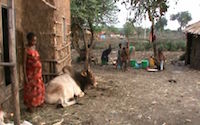Waima’a has a large number of contrasts between different ‘manners of articulation’ in its consonants. When an English speaker hears the words ‘pin’ and ‘bin’, (s)he knows that the words mean different things because the consonants /p/ and /b/ contrast in English. The ‘place of articulation’ for each is the same: both are ‘bilabial’ (sounds made with the lips), but they differ in their ‘manner of articulation’ — the /p/ is ‘voiceless’ but the /b/ is ‘voiced’. This contrast is important in English but other languages might have more or less contrasts than are found in English.
An example is Hindi which has a sound in the same place, but with a different manner of articulation, which we can write /ph/. This sound is similar to the English /p/ but is aspirated (it is pronounced with a puff of air). This means that where English has two words ‘pin’ and ‘bin’, Hindi could have three, ‘pin’, ‘bin’ and ‘phin’. English speakers would not hear the difference between ‘pin’ and ‘phin’ except as a slight pronunciation difference. In the same way, some languages do not use these particular contrasts at all. For most of the indigenous languages of Australia /p/ and /b/ do not contrast, so these will be heard as the same sound and /pin/ and /bin/ (and phin) would be heard as slightly different pronunciations of the same word.
Following are sound files to illustrate some of the contrasts found in Waima’a (the full orthography is here.
| Contrast | Example words | Sound File | |
| k’/k | k’ii/kii |
|
|
| kh/k | kholi/kole |
|
|
| l’/l | l’uka/luho |
|
|
| lh/l | lhobe/lohi |
|
|
| m’/m | m’utu/muto |
|
|
| mh/m | mhee/mee |
|
|
| n’/n | n’ini/nini |
|
|
| nh/n | nhala/nala |
|
|
| p’ | p’ita |
|
|
| ph/f | phorti/forti |
|
|
| r’/r | r’asi/rasai |
|
|
| s’/s | s’aka/sala |
|
|
| t’/t | t’ode/toke |
|
|
| th/t | thidi/timi |
|
|
| w’/w | w’ide/wide |
|
|
| wh/w | whai/wai |
|
© The Research School of Pacific and Asian Studies, the Australian National University.
International students: ANU CRICOS provider number is 00120c
Please direct all comments or suggestions to the maintainer, John Bowden.
This page last modified on 10 January, 2003.







